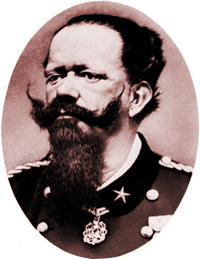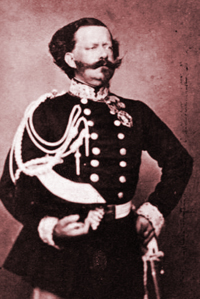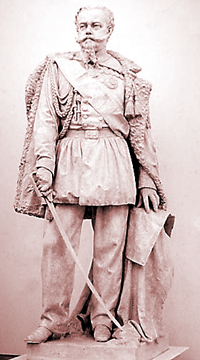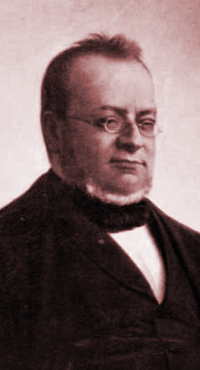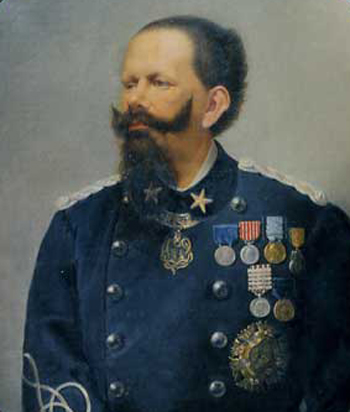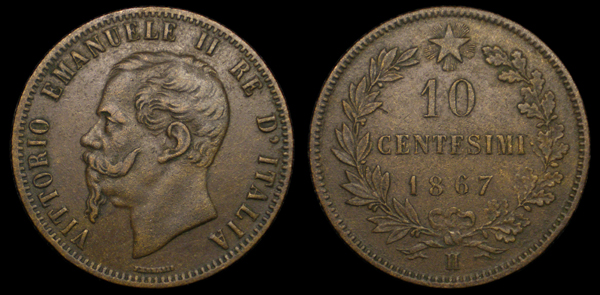
10 CENTESIMI COIN - ITALY - KING VITTORIO EMANUELE II
(KM 11. 3H)
Date: A.D. 1867
Obverse: Portrait head left - VITTORIO EMANUELE II RE D'ITALIA FERRARIS
Reverse: Wreath of laurel and oak with star - 10 CENTESIMI 1867 H
Engraver: Giuseppe Ferraris
Conte di Cavour, Prime Minister and loyal advisor to the king. |
This is a 10 Centesimi coin depicting Vittorio Emanuele II, first king of a united Italy and last king of Piedmont-Sardinia. Vittorio Emanuele II was born on March 14, 1820 at Torin, in the Kingdom of Sardinia (Northern Italy). He was the eldest son of Carlo Alberto Amedeo (Charles Albert) of the House of Savoy, King of Piedmont and Sardinia, and his wife Princess Maria Theresa of Tuscany, Archduchess of Austria, Princess of Hungary and Bohemia. His father became King of Sardinia-Piedmont in 1831 when Vittorio was 11 years of age. The young prince was educated in the strict etiquette of the Piedmont court and received rigid military and religious training as a young man. He took great interest in military matters but seemed to disdain politics. In an attempt to improve relations with Austria which held parts of Italy, his father arranged for him to be married to his Austrian cousin Maria Adelaide Di Lorena, daughter of Archduke Rainer, in 1842. The marriage did little to improve strained relations between the Italian states and the Austrian empire under the rule of Franz Joseph I. Riots broke out throughout Italy and Europe led by revolutionaries looking to implement more democratic systems. His father was forced to make concessions to the democrats agreeing to a constitutional regime that would remain in place for the next century. Taking advantage of the upheaval, The Kingdom of Lombardy-Venetia, under Austrian rule, revolted as did most of Sicily. His father formed an alliance with the Papal States and Sicily who declared their independence. In 1948 he went to war with Austria whose position in Italy had been weakened. Vittorio was thrilled as he had trained for much of his life for just such a moment and he saw the First War of Italian Independence as a chance to distinguish himself as a soldier and military commander. He was given command of a division and by all accounts was an able commander who led by example. He was wounded at Goito where it is said he showed great bravery and Italian forces were victorious. Papal and Sicilian troops withdrew over various concerns leaving Sardinia to continue the war alone. After a defeat at Custoza an armistice between Austria and Sardinia was agreed upon in 1948. A year later Carlo Alberto denounced the truce prompting the Austrian army to go on the offensive leading to a heavy defeat for the Piedmontese at Novara. The Piedmontese were driven back and Austrian forces prepared to move on Turin. Having rejected the peace terms offered by the Austrian Field Marshall Radetzky, Carlo Alberto abdicated in favor of his son, and withdrew to a monastery in Portugal where he died a few months later. At the age of 29 Vittorio Emanuele II inherited a defeated kingdom and the daunting task of negotiating terms of peace with the Austrians. There are several reported versions of his meeting with Field Marshall, Josef Radetzky. Regardless of what transpired and who took what stance, the result was the forced surrender of territory, a payment of 65 million francs in reparations to Austria, the withdraw of his fleet from the Adriatic, and he was to disband his army of Lombard, Polish, and Hungarian volunteers. By this time his popularity was not much better than his fathers. He responded to a revolt in Genoa with brutal force seeing them as cowards taking advantage of a weakened state. The country was defeated, broke, the army was in disarray and he was generally despised by his people and characterized as a traitor. The Chamber of Deputies rejected the terms of peace with Austria. Knowing that further conflict with Austria would be disastrous if not simply impossible, he fired Prime Minister Claudio Gabriele de Launay, replacing him with Massimo D'Azeglio. In his proclamation from Moncalieri he appealed to the people and asked for their loyalty and called for unity in a time of crisis. The new chamber ratified the treaty on January 9, 1850. On November 4, 1852 he appointed Camillo Benso, Conte di Cavour Prime Minister of Piedmont. Cavour was an astute political tactician and became his chief, and ever loyal, advisor. Generally liberal, he believed in free trade, public right of opinion, and secular rule, but was still an enemy of the republicans and revolutionaries inside Piedmont. He would remain Prime Minister and loyal advisor to the king, save for a brief resignation in protest, until his death in 1861. Cavour and the King would set themselves to the task of repairing and managing the kingdom, reorganizing the army, the administrative institutions, the economy, and opening the country to industrialization and international commerce. The Kings popularity with his people was slowly restored over the next decade. 1855 was a bad year for Vittorio Emmanuel. His mother, Maria Teresa, his wife, Queen Adelaide, his brother Ferdinand, duke of Genoa, as well as his new born son died within a few weeks of each other. Although the year brought personal tragedy to the King and his family. It was also the year that Piedmont-Sardinia chose to join France, Britain, and the Ottoman Empire in their fight against Imperial Russia in the Crimean War. The motivation for joining the war was the possibility of gaining support from powerful allies like France in their plans to expel Austrian from Italy and unify the Italian states. Letters between Cavour and the King show that plans were made for France to support the Italians in a conflict between Piedmont-Sardinia and Austria. During several meetings between the able minister and Napoleon III, emperor of France, the two hashed out what they could pass as valid reasons for going to war and terms for Frances support as well as who would get what. These meetings resulted in the Treaty of Plombières. One subject discussed was the strong desire held by Napoleon III that his cousin, Prince Napoleon Joseph, marry the daughter of the king, Princess Ludovica Teresa Maria Clotilde. The king was not in favor of the union as he felt he was not fit to marry his beloved daughter. In a letter to the king Cavour argues the case for marriage carefully pointing out the fact that few other suitable prospects existed, and the benefits that would be gained by the union as well as the French Emperors strong wish for the union to take place. Of the suitability of Prince Napoleon Joseph he writes: "The private life of the Prince may have sometimes been unsteady, but it has never given occasion for serious reproach. He was always a good son, and though he has angered his cousin more than once, still in serious matters he has always remained faithful and close." In order to assure support from the French emperor, the king agreed and the two were married on January 30, 1859. The plan as discussed called for Emanuele to give up rights to Savoy, a hard pill to swallow as it was the hereditary home of his family. It promised support to Sardinia in the event that war broke out with Austria. France would assist the Italians in getting a loan in Paris, The Italian states would then form a confederation. The stated purpose of the war being 'the complete deliverance of Italy, it shall be pursued until this purpose should be achieved.' Cavour and the Emperor of France discussed how they could provoke war without appearing to be the aggressors thus gaining the sympathies of other nations. An excerpt from a note to the King sent by Cavour shortly after a meeting with the French Emperor described what transpired: "we set ourselves to discussing each state in Italy, seeking grounds for war. It was very hard to find any. After we had gone over the whole peninsula without success, we arrived at Massa and Carrara [two small duchies owned by the Duke of Modena; under martial law imposed by Austrian troops] , and there we discovered what we had been so ardently seeking. After I had given the Emperor a description of that unhappy country, of which he already had a clear enough idea anyway, we agreed on instigating the inhabitants to petition Your Majesty [i.e. Victor Emanuel] , asking protection and even demanding the annexation of the Duchies to Piedmont. This Your Majesty would decline, but you would take note of the Duke of Modena’s oppressive policy and would address him a haughty and menacing note. The Duke, confident of Austrian support, would reply impertinently. Thereupon Your Majesty would occupy Massa, and the war could begin." In the end, Emanuele and his minister Cavour provoked Austria by mobilizing the military close to the border. Austria began mobilizing on April 9, 1859 and issued an ultimatum for Piedmont to demobilize on the 23rd. Cavour rejected the ultimatum, Austria invaded Piedmont six days later. The Kings forces held off the Austrian advance by various means until Napoleon III arrived in Alessandria, taking the command of the operations. French forces were far outnumbered but were able to push Austrian forces back. The Austrian Emperor Franz Joseph I took personal command of Austrian forces and met the French at Solferino. While not a great defeat, circumstances caused the Austrian army to retreat. Austrian forces were also defeated by Italian volunteers under Giuseppe Garibaldi, a leader in the Republican and unification movements. The French Emperor did not want a prolonged, bloody affair, nor did the Austrian Emperor who was facing a myriad of other problems. Napoleon III and Franz Joseph signed the armistice of Villafranca on July 11, 1859 without consulting his Italian allies. Knowing he could not continue the war without the French, and to keep France as an ally, Emanuele begrudgingly accepted the terms of the armistice which called for, among other things: 1. The formation of an Italian Confederation.
Austria kept Venetia and the Italian states were joined into a confederacy with Pope Pius IX at its head but with Vittorio Emanuele at the head of the most powerful state in the union. Upon hearing of the kings acceptance of the agreement, Cavour angrily resigned his position only to return the next year accepting that the Kings decision, in the long run, was the right course of action. The King, Cavour, and his revolutionary ally Giuseppe Garibaldi set out to complete the unification of Italy. Tuscany, Romagna, Parma, and Modena all voted for a union with Sardinia. This was against the peace treaty but France turned a blind eye after receiving Nice and Savoy. Garibaldi and his men went south and moved northwards, Victor Emmanuel and his men moved from north to south with the intention of annexing all remaining territories in their path. As he moved against the papal states, the pope excommunicated him. Although a devout Catholic, he continued undeterred and led his army in person through the Papal States, occupying the Marches and Umbria, to Naples. The Papal army was defeated at Castelfiardo. On October 29th he met Garibaldi and soon counted Naples and Sicily as part of his territory. All of Italy save Rome and Venice was now under the rule of the King of Piedmont-Sardinia. On February 18, 1861, Victor Emmanuel was declared the king of Italy but Italy was still yet to be completely unified. Garibaldi wanted to take Rome but the king, fearing the wrath of the French, stopped him by force. Garibaldi was defeated and captured, but later given amnesty. Although the Emperor Napoleon III had turned a blind eye to Emanuel's annexations and advances against papal land in violation of the treaty, he would not allow Rome to fall to Emanuele and kept troops in the city to protect it. Rome was off limits but Venetia was another story. On April 8, 1866 the Italian government signed a military alliance siding with Prussia in the Austro-Prussian war. Although Italian troops did not fair very well, in the long run Austria was unable to continue a prolonged conflict and with the help of Napoleon III as mediator, the king was awarded Venetia. Victor Emmanuel moved his capitol from Turin to Florence in 1865. Rome and the pope remained the final obstacle to a unified Italy. After two unsuccessful attempts to take Rome by Garibaldi, the road to Rome was opened to the King by the outbreak of war between France and Prussia. The French emperor, who had been such a boon to the king, looked to his Italian allies for assistance. Emmanuel offered assistance on the condition that the French Emperor cease his involvement in Rome. Napoleon did not relent and the the King remained neutral. French losses forced the emperor to withdraw his troops from Rome. Napoleon III was defeated, surrendered, and was taken prisoner by Prussian Field-Marshal Helmuth von Moltke, Prussian King Wilhelm I, and Prussian Chancellor Otto von Bismarck on September 2, 1870. On September 10, 1870, Italian troops occupied Rome. On July 2, 1871 King Vittorio Emanuele II made his entry into Rome which would serve as the new capitol of a unified Italian kingdom. The pope was relegated to the Vatican and the loss of Rome destroyed any hope of reconciliation between the church and the new kingdom. The Pope and the king dwelt side by side in Rome without ever meeting. Victor Emmanuel devoted his remaining years to consolidating his kingdom at home and improving Italy's international standing. In 1873 he visited the emperor Franz Joseph at Vienna and the emperor Wilhelm I at Berlin. Although he was well received by both Emperors, his visit to Vienna was never returned by the Austrian Emperor who was a Catholic sovereign and feared such a visit would offend the pope. This served to embitter Austro-Italian relations though there would be no further conflict between the Italian King and the Austrian Emperor. On January 9, 1878, Victor Emmanuel died of fever in Rome and was buried in the Pantheon. The king has been described as hearty, good-natured and simple in his habits. A firm believer of the absolute right of a king to rule absolutely, he was able to reconcile these beliefs under a constitutional monarchy. Under his gruff exterior was a sharp intellect and an able statesman. Though not the greatest of military leaders, as a soldier he was very brave. He was a keen sportsman and loved to hunt spending days in the mountains chasing game. He had a good relationship with his wife Adelaide, who bore him several children, but he also had a great weakness for the fairer sex and kept several mistresses. He was succeeded by his son Umberto I.
|

